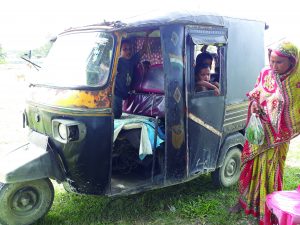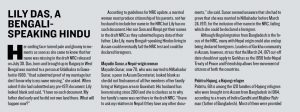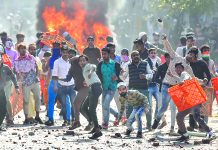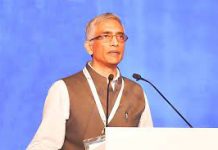 Many, perhaps the entire country started to look at Assam with shock and surprise after July 30 morning when the second draft of National Register of Citizens (NRC), 1951, was released with over 40.07 lakh residents missing in the draft. NRC is believed to solve the illegal Bangladeshi migrants problem that Assam is facing since the Partition.
Many, perhaps the entire country started to look at Assam with shock and surprise after July 30 morning when the second draft of National Register of Citizens (NRC), 1951, was released with over 40.07 lakh residents missing in the draft. NRC is believed to solve the illegal Bangladeshi migrants problem that Assam is facing since the Partition.
Sailesh, the Register General of India (RGI), releasing the draft in Guwahati said of the total 3, 29, 91, 384 applicants, 2, 89, 83, 677 were found to be eligible for inclusion in the draft NRC with March 24, 1971, as the cut-off date. This means 4,007,707 applicants allegedly “failed” to prove that they or their forefathers came in Assam on or before March 24, 1971, as per the cut-off date in Assam Accord , 1985, signed by former Prime Minister Rajiv Gandhi and those leading the “historic” Assam Agitation or the anti-foreigners movement between 1979 and 1985.
This sparked strong criticism from international media, many of whom projected it as an “anti-Muslim” despite the fact that those who missed the draft NRC belonged to different religions and the indigenous people too. It is to note that the work on NRC began following an order of the Supreme Court in 2013 and is being monitored by the apex court.
The Centre and Assam government have repeatedly assured that those who were left out had nothing to worry and could submit their claims of citizenship between August 30 and September 28 for the inclusion of their names in the final updated NRC, likely to be released in December.
Many in Assam now fear that this would turn into a “humanitarian crisis” once the final NRC is out as India is unable to deport the migrants due to lack of a deportation or repatriation treaty with neighbouring Bangladesh.
“If the number of foreign nationals who settled in Assam after March 24, 1971, is huge and their country of origin do not want to take them, what will be their fate? They are India’s
liability: whether we like them or not. It will be a humanitarian crisis for India,” said former director general of Assam police, Harekrishna Deka, in his post on Facebook. Deka, also a Sahitya Akademi awardee, was a superintendent of police and a deputy inspector general of police during the Assam Agitation.
Confusion and fear of being declared “Bangladeshis” was all prevalent at Hatisola and four other neighbouring villages having maximum Bengali Muslim population in Kamrup district, about 80-km west of Guwahati where nearly 5,000 residents missed their names in the draft NRC.
Ainal Hoque, a 47-year-old farmer looked confused as he came rushing to NRC Seva Kendra at Hatisola with documents. Names of him and a son, Aminul, 8, were there in the first draft of NRC released on December 31 last year but the final draft saw names of all six members of his family missing.
“On August 6, I got a letter saying that the names of my family were dropped as a case is registered in the Foreigner Tribunal where I have to prove that I am not a foreigner. But, I did not receive any notice neither from a tribunal nor from police about the case earlier. I had submitted 1966 voters list which had my father’s name (Asmut Sheikh) as a legacy data to prove our citizenship and inclusion in the NRC,” a visibly worried Ainal told the Tehelka at Hatisola.
“Names of my elder brother’s family is there who had submitted the same legacy data of our father. Now, I am clueless what to do,” he said.
Many like Ainal crowded the Seva Kendra on August 10 when the process began to collect forms for submission of claims for inclusion in the NRC.
Large number of Muslims like Ainal’s forefather were welcomed by the British to Assam in the 19th century to grow food in the vast barren lands in the state. Bengali Hindus migrated during and after the partition, mainly due to “religious persecution” in East Pakistan, which became Bangladesh in March 1971. Many returned after Bangladesh was liberated but some stayed back fearing threat in their home.
The flow of the migrants to Assam, however, continued even after 1971 as vast stretch of the 263-km border with Bangladesh remained unfenced and those who settled in Assam got “support” from some political parties. The continuous infiltration of illegal migrants from Bangladesh left the indigenous people increasingly threatened of losing their identity, culture and become politically weak against the fast-growing population of the “Bangladeshis.” This triggered the Assam Agitation mainly led by All Assam Students’ Union (AASU) between 1979 and 1985, in which 855 indigenous people sacrificed their lives while thousands of suspected Bangladeshi migrants had also died in attacks by the anti-foreigner agitators. The agitation ended with the signing of the Assam Accord in 1985 which primarily agreed to detect and deport illegal migrants from Bangladesh and safeguard the identity of the indigenous Assamese.
The updated NRC is likely to detect the post-1971 migrants, as agreed in the Assam Accord but their deportation is a challenge before the country.
So what would be the fate of those to be identified as “foreigners” through NRC?
“They can’t be treated like Rohingyas of Myanmar. They should be specifically given opportunities to earn the livelihood for survival, dignity or existence and opportunities for their children’s future. In such a circumstance, the government of India will have to treat them as a special category of foreigners as it was done for the Tibetan refugees. They have to be given a special identity card as resident foreigners by bringing in an amendment in the Foreigner’s Act. But there should be the restriction on voting and transfer of land for them,” suggested Deka.
Many, however, said such a mechanism was possible for the Tibetans as their number was less.
Former union home secretary, G K Pillai recently said in New Delhi that those be identified as foreigners could be given a work permit, a suggestion quickly rejected by local organisations including the influential AASU, which continued to demand implementation of the Assam Accord in letter and spirit: detection and deportation of the foreigners.
Assam’s experience of dealing with the foreigners so far has not been easy. Of the 79,000 persons declared foreigners by tribunals since 1985, more than 30,000 have gone missing while another 30,000 were “pushed back,” in which the foreigners are taken to the border and sent back across. More than 1,000 others are lodged in detention camps in six jails across Assam while another 2 lakh cases of suspected foreigners are pending in 100 foreigner tribunals, a quasi-judicial body dealing with suspected foreigners.
The humanitarian crisis situation
Assam is staring at the situation due to lack of an action plan about the fate of the foreigners to be identified in the NRC, according to many, could result in further conflicts similar to those during the Assam Agitation. Hindu hardliner groups like Vishwa Hindu Parishad or Antarrashtriya Hindu Parishad led by former VHP leader Pravin Togaida, said those to be identified as Bangladeshis should be “thrown into the sea” or Indian army should capture a portion of Bangladesh and settle the migrants there. Many, however, termed the statements as “communal and divisive” with a political motive.
Upamanyu Hazarika, a Supreme Court lawyer who leads Prabajan Virodhi Manch has a straight answer: “The foreigners would leave Assam of their own if Assam government passes a legislation by reserving jobs, seats in educational institutes and land only for those whose forefathers were residents of Assam in 1951.”
Post-NRC way forward
Update of the National Register of Citizens (NRC), 1951, in Assam with March 24, 1971 cut-off will fulfil the 33-year-long promise in the 1985 Assam Accord signed between former Prime Minister Rajiv Gandhi and the anti-foreigner agitators led by All Assam Students’ Union.
Many in Assam, however, say a correct NRC would only be a partial implementation of the historic Accord that promised detection and deportation of the foreigners, sealing of the India-Bangladesh borders in Assam and constitutional, legislative and administrative safeguards to indigenous Assamese population.
“The ultimate solution to the threat posed by influx to Assamese identity and culture lies in the implementation of the Assam Accord in to,” AASU leaders said in Guwahati, days after the second draft of NRC was released.
While the BJP-led government in the state said the 48-km (still unfenced borders) of the total 262-km Assam-Bangladesh border, would be fenced by December this year, many in Assam believe that the demand for constitutional and administrative safeguards would step up after the publication of the updated NRC.


Clause 6 of Assam Accord says Constitutional, legislative and administrative safeguards, as may be appropriate, shall be provided to protect, preserve and promote the cultural, social, linguistic identity and heritage of the Assamese people. The clause, however, has remained unimplemented mainly due to lack of a definition of who is an indigenous Assamese.
Assam government in 2015 had said that the term Assamese people shall mean and include all indigenous tribals, non-tribals and local linguistic population of Assam living within the four geographical boundaries of the state and all genuine Indian citizens who have permanently settled within the four geographical boundaries of Assam and accepted practices, propagated and patronised the local language and culture of Assam as their own. This definition, however, has not yet been accepted by many including AASU which proposed that those enlisted in the 1951 NRC and their descendants are Assamese.
The ever growing fear of the indigenous people about the threat posed to their identity and culture by “foreigners” was evident when Narendra Modi-led government introduced the Citizenship (Amendment) Bill, 2016 in the Parliament. The bill seeks to expedite the process of granting citizenship by naturalisation to persecuted Hindu, Sikh, Buddhist, Jain, Parsi and Christian communities who entered India from Pakistan, Bangladesh and Afghanistan before December 31, 2014. Thousands spilled onto the streets in May this year when the Joint Parliamentary Committee held its hearing in Guwahati and Silchar in Barak Valley. Although BJP is eager to pass the Bill to fulfil its pre-poll promise of citizenship to the “persecuted Hindus,” Asom Gana Parishad, its ally in Assam and student bodies like AASU is strongly against it.
Many in the Bengali dominate Barak Valley (three districts in South Assam), however, are in favour of the Bill.
“The basic fear of the ethnic people of Assam is that the language of migrated people from East Pakistan or Bangladesh: be it Hindu or Muslims is Bengali. The proposed provision in the Citizenship Act 1955 will give the illegal migrants the citizenship right despite even coming to Assam after March 24, 1971, and this will affect the entire ethnic people because of the threat faced by the indigenous people in their language, culture and heritage,” said a memorandum submitted to the JPC by Prafulla Kumar Mahanta, who lead the AASU during the agitation. Mahanta contested and won elections after signing the Accord in 1985 and became chief minister twice.
So, what could be the nature of safeguarding the indigenous Assamese as promised in Clause 6 of Assam Accord?
On this, Harekrishna Deka said, “It could be reservation of seats in the Legislative Assembly, in government jobs, in educational institutions, in government contracts up to a financial limit, restriction on transfer of land prohibiting non-indigenous from purchasing land, which is a utmost importance.” Many have been demanding that the safeguards be applicable to those who were Assam citizens in 1951 or before.
Amid the efforts to finalise the draft NRC, groups representing indigenous communities have stepped up agitation demanding Scheduled Tribe status to six more ethnic communities in the state: Tai Ahom, Moran, Mottock, Chutia, Koch Rajbongshi and Adivasis or those working in tea gardens. The Centre has set up a committee to work out modalities but the delay in filing its report has angered the groups.
The Centre has also decided to set up a committee to finalise the definition of who is an indigenous Assamese and till then the state’s population is set to be divided into three categories: the post-1951 citizens, those between 1951 to 1971 and the post-March 24, 1971 or the illegal migrants.
letters@tehelka.com













